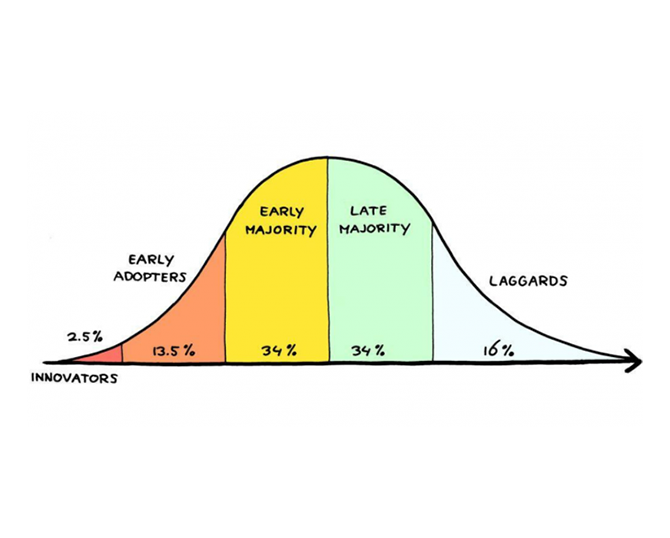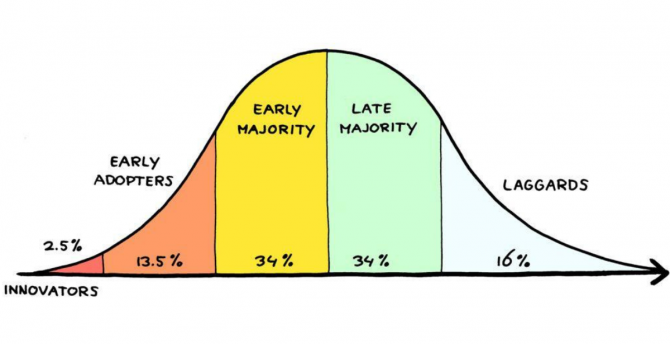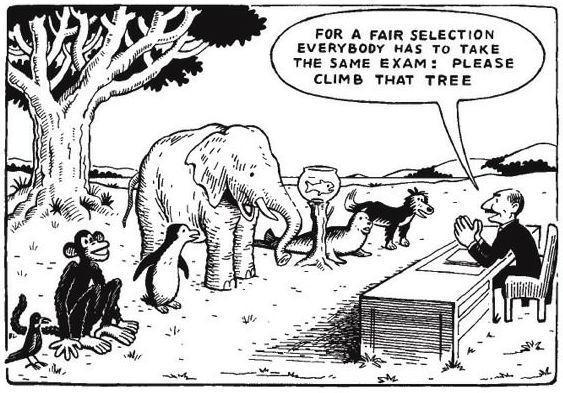
Dr. Lyall Swim | Chief Innovation Officer
The Five Inflection Points that Help Drive an Idea to Mass Adoption
Milton Friedman once noted that the role of think tanks is to “primarily keep options open, to have available alternatives, so when the brute force of events makes a change inevitable, there is an alternative available to change it.” Friedman’s sentiment is often cited as a kind of value proposition for think tanks around the globe.
But what if Friedman’s assessment of the role of think tanks is wrong—or, at least, incomplete? What if rather than passively waiting for the inevitable to happen, think tanks develop the capacity to actually help create that brute force of events that drives change?
As it turns out, there are ways to create the brute force of events that makes change inevitable. And cultivating an understanding of how to make that happen is often the difference between those idea entrepreneurs who are successful in getting their alternatives into the mainstream versus those who continue to wait around for their idea to be adopted.
From Idea to Mass Adoption – The Theory of Diffusion of Innovations
For nearly a decade, I have been actively studying the question “Why don’t more great ideas get adopted”? And while I don’t claim to have all the answers to that question, my search for answers has yielded some key findings that idea entrepreneurs can use to go beyond Friedman’s notion of the role of think tanks moving from passive observer to active creator.
My key findings are all connected to an innovation theory developed by Everett Rogers. Rogers, in his breakthrough research in the early 1960s, found a way to visualize and demonstrate how ideas or innovations spread. His theory has come to be known as the diffusion of innovations. According to Rogers, innovation diffusion is the “process by which an innovation is communicated (or adopted) through certain channels over time among the members of a social system.” Over the past 50 years, researchers from management to marketing to public policy have used Rogers’ theory to better explain the how, why, and rate of innovation adoption.
From Rogers’ research as well as my own work in this area, I have identified five tools—marketing, measurement, messenger, modification, and mobilization—that idea entrepreneurs can use to create the kind of environment where change is inevitable.
Marketing – Communicating with the Other 97%
Diffusion theory identifies five types of adopters: innovators, early adopters, early majority, late majority and laggards. “Figure 1: Diffusion of Innovation Curve and Adopters” shows where these adopter types fall on the diffusion curve and what percentage of a population those adopters represent. One of the key differentiators between the various groups is how they respond to and consume communication about a new policy reform. For idea entrepreneurs the lesson here is that in order to help accelerate adoption of an idea, policy advocates must also vary how they message a policy idea to these various groups of adopters.

Figure 1: Diffusion of Innovation Curve and Adopters
For any innovation to even begin the diffusion process, innovators must be on board. Innovators are the true believers–the proverbial “choir.” They pride themselves on their philosophical purity and on being well versed in the technical details of various policies of their interest. Innovators are the ones who read every white paper and pride themselves on being the true experts. As long as the data is good and the rationale argument is sound, they are on board. Innovators don’t have to see the reform actually work. For them adoption is a process of logical and philosophical alignment. To effectively communicate with innovators, idea entrepreneurs need to lead out with the technical details of a policy proposal.
While innovators are critical at the start of the diffusion process, this group represents only 3 percent of the potential adopters of a policy idea. The remaining 97 percent have little time or patience to translate those technical details or features of a policy reform into the benefits of the idea or the broader meaning of the policy reform. Further, the language used to communicate the in-depth research to the innovators often alienates the remaining 97 percent and creates a wedge between the idea entrepreneur and the broader support needed to ensure the “inevitable” adoption of the policy reform.
The remaining four groups of adopters don’t decide to adopt because of the soundness of the arguments or because of the in-depth analysis provided in a comprehensive white paper. They choose to adopt a policy because of what that policy reform means to them and because of the associated benefits. For idea entrepreneurs, this means that in order to facilitate adoption of their ideas with the remaining 97 percent they need to shift their messaging strategy to focus on (a) communicating the specific benefits that are attractive to the 97 percent, (b) eliminating jargon or words only the innovators understand, and (c) identifying the deeper meaning of the reform that connects to the heart of the other four types of adopters.
In India, the Centre for Civil Society (CCS) created an in-depth policy report about free-market reforms that India could adopt to further economic freedom and raise the standard of living for the country. The report fell flat. After researching the reasons behind the poor reception, CCS learned that the term “economic freedom” had no connection with the broader Indian population. In fact, Indians viewed economic freedom negatively and as something that only applied to the wealthy and connected. CCS realized they needed a new term if they were going to get the average Indian to support their ideas, so they substituted “livelihood freedom” in place of economic freedom. Even the poorest of Indians is seeking to have a livelihood. With this new meaning-based terminology, CCS was able to accelerate the adoption of several of their economic reforms.
Measurement – Redefining Success in Freedom’s Terms
Any time a change is introduced into a system, movement builders need to carefully evaluate how what is measured or considered as success needs to change. The more radical the shift from the norm the policy creates, the more imperative it is that the definition of success is redefined or changed altogether.
A sure way to undermine a policy reform effort is to measure the success of that reform by the terms of the current policy environment. For those advocating for reforms that move us toward a more free society, this means that idea entrepreneurs cannot expect freedom-oriented reforms to succeed as long as those reforms are measured by tyranny’s standards.
One of the clearest examples of the failure to redefine success is in the education policy sphere. For decades now, standardized tests have been the de facto standard against which all reforms are measured.

This standard of measurement is a legacy measurement tool of the industrial revolution and is by its very nature a non-individual measurement form. It is the perfect measurement tool if we, like the Prussians who pioneered our current form of education, want to create standardized humans. But this type of measurement will doom any education reform that begins to attempt to treat students as individuals, because the standard of measurement by its very nature rewards reforms that create more standardization.
On the flip side, the Georgia Center for Opportunity has been highly proactive in redefining what success looks like as it relates to reducing or eliminating poverty in Georgia. They have created a framework called, perhaps not coincidently, the Success Sequence. Their Success Sequence defines three measurement standards by which reforms can be evaluated. By identifying these measurement standards, GCO has now defined for the policy environment the way in which success can be achieved or should be achieved versus prior measurement regimes that far too often rewarded increased enrollment and perpetual dependency.
Messenger – Identifying the Right Face of Reform
Having good messaging and redefined success standards in place help ensure that a reform gets some initial momentum, but these may not be enough to ensure that a reform makes it over what some researchers refer to as the diffusion chasm—the space between the early adopters and the acceptance of the early majority of the idea.
One of the reasons for a movement or policy idea stalling out or failing to cross the chasm is connected to who is perceived to be the “face” of the movement or idea. For most ideas or movements, the innovators often become the de facto face of a particular policy reform movement. This is understandable. Innovators have an in-depth knowledge of the reform. They have a real passion for the ideas and the philosophy behind those ideas. And last but not least, they were there first when no one else that could be the face of the reform when it began the diffusion process.
However, as noted earlier, innovators are viewed as outsiders, as weird, as “not like me.” For a policy reform movement to cross the chasm, idea entrepreneurs need to help the innovators give up that spot as the face or front of the movement and hand that position over to an early adopter. While not as well-versed in the details or perhaps as philosophically pure as innovators, early adopters are seen as trustworthy opinion leaders and reside much closer to and interact regularly with the early majority and late majority adopters.
This passing of the torch to a new face of a policy reform movement is well illustrated by the recent success of criminal justice reform in the United States. In the 1980s a few left-of-center policy advocacy groups began to sound the alarm on the criminal justice system in the U.S. While they were successful in getting some initial momentum toward reform, their efforts stalled out. In fact, the momentum gained was actually replaced by an alternative wave of “getting tough on crime,” and the passage of harsh sentencing laws like California’s Three Strikes law.
In 2007, a new face of the movement emerged—the Texas Public Policy Foundation (TPPF), a state-based, right-of-center public policy group. TPPF was later joined by other right-leaning think tanks around the country in calls to reform the criminal justice system. With this push coming from right-of-center groups, legislators began to shift positions on criminal justice reform policies. TPPF was able to help pass the first set of reforms in Texas in 2010. Now in 2019, all 50 states have begun to make changes to their criminal codes and justice systems.
Modification – Perfection is the Enemy of Progress
In diffusion theory, researchers have found that innovations are not static. Innovations change or are modified over time as they go through the diffusion process. This modification process is often referred to as reinvention.
The policy diffusion often follows a similar path and is perhaps even more likely to see modifications along the path to full adoption for two reasons. First, no policy or form of government is perfect. Winston Churchill is quoted as saying, “Democracy is the worst form of government, except for all the others.” While principles of good government, human flourishing, and peace are timeless and universal, their application in the form of actual public policy is not.
Second, efforts to get policy passed it often require the creation of coalitions whose interests while mostly aligned around the policy are never perfectly aligned generally, and so as an idea or reform goes through the policy making process members of the coalition in large or small ways often looks to tweak or adjust the reform to more closely align with their core set of values or philosophy. In addition, there are those that are completely opposed to the idea who may be actively trying to change the idea so that it looks nothing like the original version of the policy reform.
The challenge for movement builders is to help guide the policy making process in such a way that progress toward a more free society is achieved while ensuring that cries for perfection from the innovators or purists as well as the laggards (or categorically opposed) don’t derail positive change.
Mobilize – Connecting with the Average Citizen
The final aspect of brute force in creating an environment where change is inevitable comes when idea entrepreneurs are able to engage the Early Majority and (to a lesser extent) the Late Majority in making the policy reform “their own.” It is at this point where the Overton Window, which defines the range of public discourse, truly shifts in one direction or another because the attitudes of society—and not just of policy makers—shifts either toward more freedom or less freedom.
Making a reform one’s own means first that the adopter has personally aligned with that singular idea. Idea entrepreneurs should not make the mistake of assuming that just because the early majority or late majority has demonstrated acceptance of the policy idea that those same adopters completely agree with all of the underlying philosophy, have a full grasp of the facts or are supportive of the idea entrepreneur’s entire agenda.
The second indication that an early majority or late majority adopter has made the reform idea their own is they take some form of public action that demonstrates their endorsement of the policy reform. Public actions could include sharing content on social media, attending at a forum or educational event, participating in an email campaign to influence a politician, penning a letter to the editor or putting a sign up in their yard. These actions are indicative that the adopter has not only gotten to a place where they accept the idea or align with it, they are actually willing to use personal resources and/or reputation to move that idea forward.
A recent effort by the Lipa Taxpayers Association in Croatia demonstrates the impact of this. After the Croatian government passed a law that would have raised property taxes on homeowners, Lipa began a campaign to repeal the tax. The early aspects of the campaign included enlisting influential economists, an in-depth economic analysis of the impact on Croatia, and a public awareness campaign. All these efforts were critical in creating an initial wave of momentum, but Lipa took it a step further. They connected with everyday Croatians, encouraging them to get involved in Lipa’s signature campaign—and because of their efforts, their profile and momentum grew so big that change became inevitable. Armed with more than 145,000 signatures and letters, Lipa was successful in getting the property tax repealed. Even more exciting, the engagement of the public at such a level has essentially created an environment in Croatia where any new or increased tax has immediate opposition.
No Guarantees, But Far Better Odds
There are no guarantees in the idea entrepreneur space. Society is a dynamic and often unpredictable environment. However, by leveraging the five innovation adoption accelerators of marketing, measurement, messenger, modification, and mobilization, policy researchers and advocates can best position their ideas to be an alternative when the brute force of events creates a window for change, but also position themselves to be the ones creating the environment and events that propel their positive change. In relying on this framework, they give their ideas the best chance of being discussed, debated, and ultimately adopted into law.